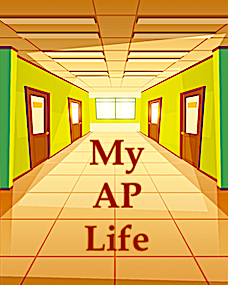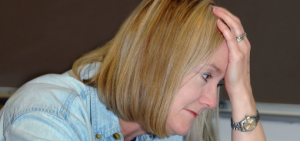Rediscovering the Best Version of Ourselves
A MiddleWeb Blog

If your school district is like mine, you have probably seen an increase in bad behaviors from staff, students, and even parents. Tensions have run high with opinions flying about mask mandates, vaccine mandates, social distancing, virtual learning, etc.
We’ve watched as our teacher colleagues, who were once lauded as heroes, have been villainized for simply doing their job. And administrators have been villainized for performing our duties that now include enforcing mask mandates, social distancing, parental/guest exclusion from the school building, etc.
I could go on and on, but I’m sure we have all been dealing with these issues in some shape or form this fall.
The discipline crisis
For our school, one of the biggest issues has been a significant uptick in discipline referrals. In the first nine weeks of this year, our discipline referrals were 310% above our first-quarter average in years past.
This increase could be for a number of reasons. But I know one of the influences has been extreme exhaustion and disillusionment on the part of administration, teachers, and students. So when I received my copy of ASCD’s October issue of Educational Leadership magazine with the title “Compassionate Discipline,” I immediately thought, “You gotta be kidding me, right?”
Who can even begin to focus on compassionate and restorative discipline when we have so many fires that we are trying to put out DAILY. I put the magazine on my coffee table and walked away. And so I kept reacting to my daily challenges and quite honestly lost my sense of compassion as discipline referral after discipline referral came across my desk.
Getting my head above the water
Weeks went by and then we had a small fall break in early October. I took that time to relax, run, and read…my three favorite Rs. I picked up my issue of October’s Educational Leadership and I began to read. I also began to interact with many of my colleagues on Twitter, and I began to be restored.
I realized I wasn’t alone in my exhaustion and frustration. I realized that many others were feeling the same pain as I was, day in and day out. And yet, they were diligently working to maintain and even increase their restorative practices with students (and teachers) every day. It is hard work, but it is worthwhile work because our students and faculty deserve it.
As I read that issue of EL, two articles struck home with me – Jane Kise and Ann Holm’s “Discipline Your Emotions” and Jeffrey Benson’s “Prevention Interviews: Listening with Intention.” I really think that these two articles hit me the hardest because they spoke to the way I used to be…the way I used to conduct myself and how I handled discipline prior to the overwhelming emotional roller coaster that has been the past year and a half of school.
Recovering our emotional intelligence
Kise and Holm’s article spoke to learning and using one’s emotional intelligence to help us “Name the judge…get composed…stay curious…[and] take action”. Although the article was written for the classroom teacher, the lessons it imparts should also be taken in by administrators.

And we know that this stress has tied directly into how they handle classroom discipline.
We know this and we as administrators have attempted to overcompensate for the stresses our teachers are experiencing every day. Unfortunately, to do this we have forsaken our own social and emotional well-being, and this overcompensation has tied directly into how we deal with school discipline on a daily basis.
Perhaps you’ve found yourself snapping at teachers when they ask you a question. Or maybe you’ve rolled your eyes as yet another discipline referral comes across your desk. Or, even worse, maybe you have snapped at a student who you were disciplining because it was the fifth or sixth time this week they’ve been in your office for something “silly.”
Maybe you’ve looked at the stack of things to do on your desk at the end of the day and thought, “why am I doing this again?” This is where being mindful and using tools like Kise and Holm’s four steps for refocusing can help. Taking a “time out” to redirect our own feelings and thoughts can go a long way to helping us maintain the restorative discipline we have worked so hard to cultivate in our buildings.
Schools aren’t very good at listening
Benson’s article begins with a very simple yet profound statement, “Schools are not very good institutions of listening.” That simple sentence had me hooked. Although we strive to be good listeners, oftentimes we are not. And when it comes to discipline, it is even harder. And that’s in a normal school year.
Now add in everything that we have been going through in the pandemic years, and I’m sure “be a good listener” isn’t at the top of anyone’s To-Do list. Yet I know that when I take the time to listen to students as they sit in my office for a discipline issue, I can usually get to the root of what happened and help students understand what made their decision unwise and why they need to be disciplined.
This year, however, I have found myself listening less and punishing more. Benson’s article helped give me a bit of a reality check.
When we take the time to be intentional in our listening, whether it’s with students or teachers, we show those we are working with that we care about them. We signal that what they have to say is important to us.
Dan St. Romain, in his book Teach Skills and Break Habits, states that we should “discipline students the way [we] would want to be disciplined.” Keeping this version of the golden rule in mind as we meet with students for discipline, especially at this traumatic time, will help us set and maintain a tone that represents the kind of disciplinarian we want to be now and in the future.
Finding our footing in the months to come
My hope for the rest of the year is that we will begin to see some of the heightened negative behaviors decline and that we as a school team will find our footing on level ground once again.
I’ve taken intentional steps to help expedite this process. I now have a cart that I wheel around the school as I conduct “office in the hallway.” This makes me more visible and encourages me to interact with students and teachers in a more positive light.
If I’m busy when a discipline referral comes across my desk, after checking to make sure it isn’t a very pressing matter I send the student back to class until I have time to listen and discipline with compassion.

Now, even if it’s just a mile, I make sure to run at least three times a week. Taking that time for myself, doing something healthy and relaxing, is helping me be happier and more patient when I’m at work.
Let’s strive to be the best version of ourselves
So as we go forward, I encourage everyone to make a concerted effort to be visible even though it is hard, to take time to listen even when we seem to not have the time, and to do something for yourself even though you are constantly doing for others. It will make us better at our work and, hopefully, happier.
Our students and our staff deserve the best versions of ourselves, and, quite frankly, we deserve the best versions of ourselves as well.



































